|
THE LUBRICATION OF ENGINES ARE CLOSED SYSTERMS, |
where the oil is the substance,which lubricates and cools working parts. 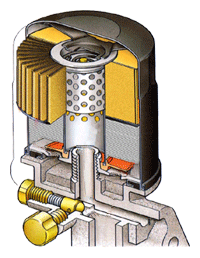 it also rinses out and transports all kinds of contamninants in the from of suspended matter from the combustion chamber, forming during the abrasive wear of working parts of the engine. Such contaminants are effectively trapped in filters, which are an important element of the lubricating system in any engine. However it should be noted that these filters cannot stop the oil degradation which is an irreversible chemical process and that is why, regardless of the kind of filter installed in ones car, the oil should be changed in accordance with the car manufacturer indications (including filters). The oil filters have different shapes and depending on the engine type may differ significanficantly regarding construction and principle of operation. it also rinses out and transports all kinds of contamninants in the from of suspended matter from the combustion chamber, forming during the abrasive wear of working parts of the engine. Such contaminants are effectively trapped in filters, which are an important element of the lubricating system in any engine. However it should be noted that these filters cannot stop the oil degradation which is an irreversible chemical process and that is why, regardless of the kind of filter installed in ones car, the oil should be changed in accordance with the car manufacturer indications (including filters). The oil filters have different shapes and depending on the engine type may differ significanficantly regarding construction and principle of operation. |
|
|
|
|
BYPASS SPIN-ON TYPE |
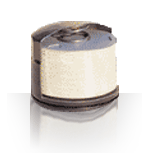 The high capacity engines often have oil systems with two types of filters. The high capacity engines often have oil systems with two types of filters.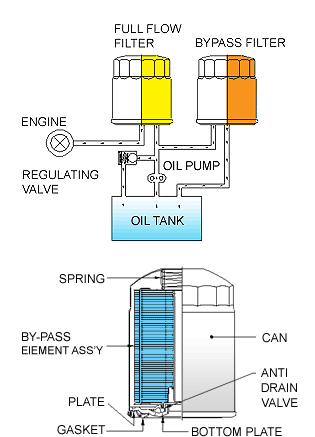 One full flow- all the oil pumped flows through while the second is built into the system in parallel and about 10% of oil flows through it. This oil after being purified goes back into the oil tank. The full-flow functions as a coarse filter while the by-pass filter is the fine filter in this system. In the oil system, centrifugal filters are often applied as by-pass filters, where contaminants are separated from the oil in the centrifulgal field of force.Filter are also used, made with a medium of special fabrics or filtering papers. The characteristic feature of by-pass filters with the medium is the amount of oil reduction during exploitation, which rusults from flow resistance increasing during the filter medium blocking. In some engines with full flow/by-pass oil system, the can filterswith two filtering cartridges (full-flow & by-pass) are applied. Such integrated filter systems take less space and its re-placement is much quicker. The oil flow is divided in such filters into the main flow directed into the engine and by-pass flow, which after proper purifications flows back into the oil tank. One full flow- all the oil pumped flows through while the second is built into the system in parallel and about 10% of oil flows through it. This oil after being purified goes back into the oil tank. The full-flow functions as a coarse filter while the by-pass filter is the fine filter in this system. In the oil system, centrifugal filters are often applied as by-pass filters, where contaminants are separated from the oil in the centrifulgal field of force.Filter are also used, made with a medium of special fabrics or filtering papers. The characteristic feature of by-pass filters with the medium is the amount of oil reduction during exploitation, which rusults from flow resistance increasing during the filter medium blocking. In some engines with full flow/by-pass oil system, the can filterswith two filtering cartridges (full-flow & by-pass) are applied. Such integrated filter systems take less space and its re-placement is much quicker. The oil flow is divided in such filters into the main flow directed into the engine and by-pass flow, which after proper purifications flows back into the oil tank.
|
|
|
COMBINATION TYPE |
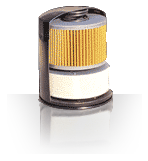 Specially, the high capacity diesel engine use the combination type oil filter the oil from the oil pump is not split. All the oil from the pump is sent to a filter, where is passes through the full flow element and then by-pass elements provided. After being filtration, the oil flows in the same way as the full-flow type. Employs a special structure that provides internal oil pressure difference to allow both the full flow and by-pass elements to maintain their specified filtering ratio The by-pass element used, made with a medium of special fabrics or filter papers. Specially, the high capacity diesel engine use the combination type oil filter the oil from the oil pump is not split. All the oil from the pump is sent to a filter, where is passes through the full flow element and then by-pass elements provided. After being filtration, the oil flows in the same way as the full-flow type. Employs a special structure that provides internal oil pressure difference to allow both the full flow and by-pass elements to maintain their specified filtering ratio The by-pass element used, made with a medium of special fabrics or filter papers.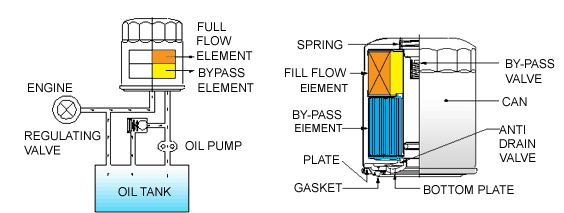
|
|
|
IMPORTANCE OF THE ANTI-DRAIN VALVE |
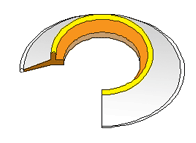 Generally, the anti-drain back valve have the form of a rubber membrane adjoi-ning the inner side of the can type filter cover. The membrane covers the holes where the contaminated oil gets through to the filter and protects from the back flow after the engine stops. The anti-drain back valve reduces the dry friction or mitigated solid friction time between working parts of the engine as protecting from the oil flow towards the pump and accelerates the oil flow into the working elements during the engine start, especially after a long break. The position the filter is screwed into the engine, conditions the valve application. If the filter works in the "cover up" position as shown in the picture below, the function of the valve is taken successfully by the gravitation. A valve is required when the filter in sore-wed in from the side or from the top of the engine body. Generally, the anti-drain back valve have the form of a rubber membrane adjoi-ning the inner side of the can type filter cover. The membrane covers the holes where the contaminated oil gets through to the filter and protects from the back flow after the engine stops. The anti-drain back valve reduces the dry friction or mitigated solid friction time between working parts of the engine as protecting from the oil flow towards the pump and accelerates the oil flow into the working elements during the engine start, especially after a long break. The position the filter is screwed into the engine, conditions the valve application. If the filter works in the "cover up" position as shown in the picture below, the function of the valve is taken successfully by the gravitation. A valve is required when the filter in sore-wed in from the side or from the top of the engine body.
|
|
|
IMPORTANCE OF THE BY-PASS VALVE |
The by-pass valve is always installed in the oil system with full-flow filter (installed in series in the system). Usually it is built in the filter itself; however there are constructions where this valve is placed in the engine body. Regardless of the place where it is installed,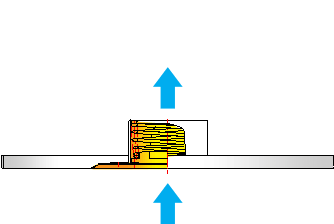 its only function is to clear the oil flow when the flow resistance is too high and there is a risk of insufficient lubrication of working parts. It is considerde though that lubricating and cooling with contaminated oil is less damaging than the lack of lubrication which may read even to the engine seizing. There are basically two reasons why the oil flow resistance in the filter, opens the by-pass valve. First : high density which hppens in winter at low temperature. While starting the car after a long stop (i.e going to work in the morning), the cold and thick oil flows on the filter medium which makes the flow difficult. The pressure increase makes the by-pass valve open. The second reason for the by-pass valve opening is the filter medium wear. When the filter is excessively contaminated, its filter medium is chocked by contaminants. In this case it may hap-pen that the by-pass valve in continuously open. To avoid such situations, it is required to change filters and oil in accordance with the car manufacturer's recommendations. its only function is to clear the oil flow when the flow resistance is too high and there is a risk of insufficient lubrication of working parts. It is considerde though that lubricating and cooling with contaminated oil is less damaging than the lack of lubrication which may read even to the engine seizing. There are basically two reasons why the oil flow resistance in the filter, opens the by-pass valve. First : high density which hppens in winter at low temperature. While starting the car after a long stop (i.e going to work in the morning), the cold and thick oil flows on the filter medium which makes the flow difficult. The pressure increase makes the by-pass valve open. The second reason for the by-pass valve opening is the filter medium wear. When the filter is excessively contaminated, its filter medium is chocked by contaminants. In this case it may hap-pen that the by-pass valve in continuously open. To avoid such situations, it is required to change filters and oil in accordance with the car manufacturer's recommendations. |
|
|
PERFORMANCE TEST OIL FILTER |
| TEST |
REQUIREMENTS |
| Initial bubble rate % |
Not less than 50% |
| Pressure drop,kgf/ |
Not greater than 0.3 (not greater than 0.02942) |
| By-pass valve opening pressure |
Within a range of opening pressure specified |
| Filter efficiency, % |
Not less than 80% at 11th hours,
and not less than 90% at the end of the test. |
| Contaminant capacity ratio, g/㎜ |
Class 1th Not less than 0.25
Class 2th Not less than 0.30 |
| Drain back Oil. ㎖ |
Not greater than 100 |
| Resistance to differential
Pressure of filter element |
Filter element shall withstand a pressure
differential of 5 kgf/㎠ (or 0.4903 Mpa)
with evidence of failure |
| Proof pressure |
Filter shall withstand a proof pressure of 15kgf/㎠ (or 1.471 Mpa) Without evidence of external leakage of harmful defect |
| Impulse |
Filter shall withstand 4x10 impulse cycles without evidence of External leakage |
| Vibration |
Filter shall withstand 5x10 vibrations without evidence of external leakage |
|
|
|
|